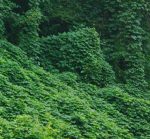 Kudzu is a deciduous woody vine and a member of the legume family, Fabiaceae, that also includes peas, beans, and lupines. It is native to Japan and was introduced into the United States as an ornamental at the Japanese pavilion in the 1876 Centennial Exposition in Philadelphia and later used for soil erosion control. Kudzu has spread into the the Mid Atlantic and Southeast where it has become very invasive, growing in field and woodland edges, roadsides, and near riparian areas. Plants prefer moist soil in full sun but are tolerant of some shade and drought and quickly grow over shrubs and trees killing them by heavy shading. Although kudzu is attractive and its roots increase soil nitrogen by means of their symbiotic relationship with nitrogen fixing bacteria, its rampant grown makes it impractical for the garden.
Kudzu is a deciduous woody vine and a member of the legume family, Fabiaceae, that also includes peas, beans, and lupines. It is native to Japan and was introduced into the United States as an ornamental at the Japanese pavilion in the 1876 Centennial Exposition in Philadelphia and later used for soil erosion control. Kudzu has spread into the the Mid Atlantic and Southeast where it has become very invasive, growing in field and woodland edges, roadsides, and near riparian areas. Plants prefer moist soil in full sun but are tolerant of some shade and drought and quickly grow over shrubs and trees killing them by heavy shading. Although kudzu is attractive and its roots increase soil nitrogen by means of their symbiotic relationship with nitrogen fixing bacteria, its rampant grown makes it impractical for the garden.
Description: With a tuber-like root, Kudzu can grow up to one hundred feet in length. It has yellow green to gray stems that can become ten inches in diameter and carry sometimes-lobed leaves consisting of three leaflets three to six inches long and with pointed ends and hairy margins. Purple flowers 1/2″ long are very fragrant and occur in long pendent clusters. They appear in late summer and give way to brown, flattened,hairy seeds pods containing three to ten seeds. Plants spread by seed but predominantly by stolons that root at the nodes.
Control: Close cut or mow the vines to the ground once a month especially during the hottest months of the summer for a year or two is effective. Remove all the cut material to prevent plants from rooting and regrowing. Alternatively, graze goats and/or sheep on the land. Once the vines have been cut, more options are available such as covering the area with plastic so as to kill the roots with the heat from the sun. This methods adds potassium from the decaying vines to the soil, a big positive especially in the Southeast. In severe cases, herbicides can be applied during the growing season to the cut vines that have resprouted. Glyphosate applied in late summer is the most frequently employed herbicide but several applications may be necessary and the herbicide may damage any vegetation that it touches.